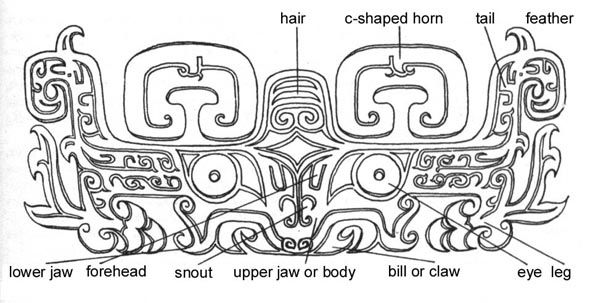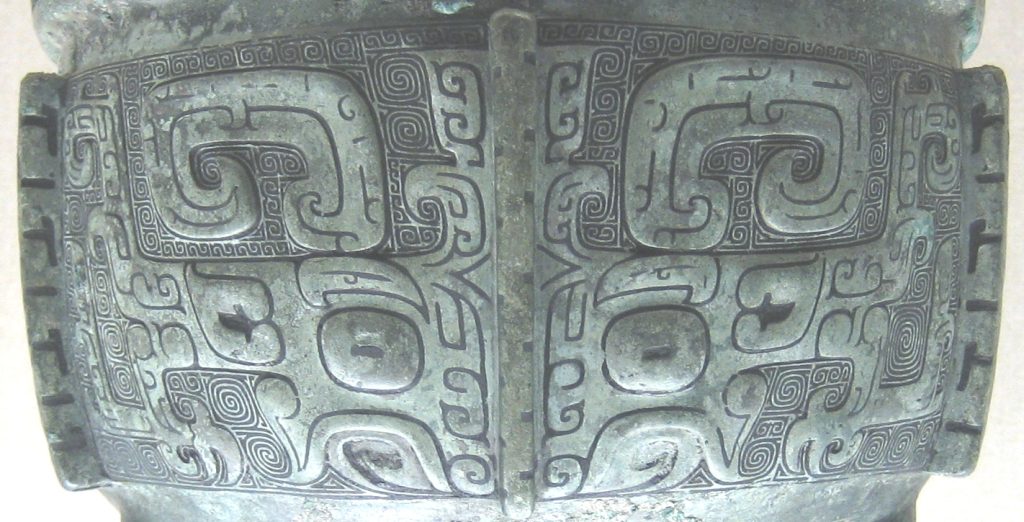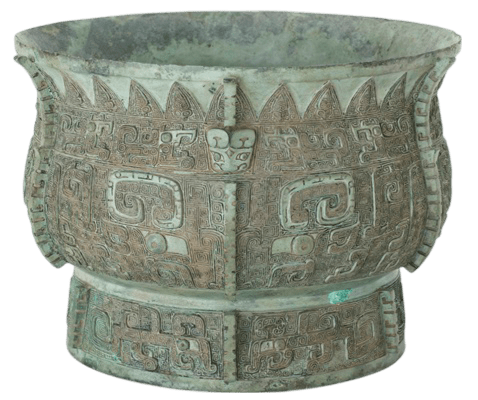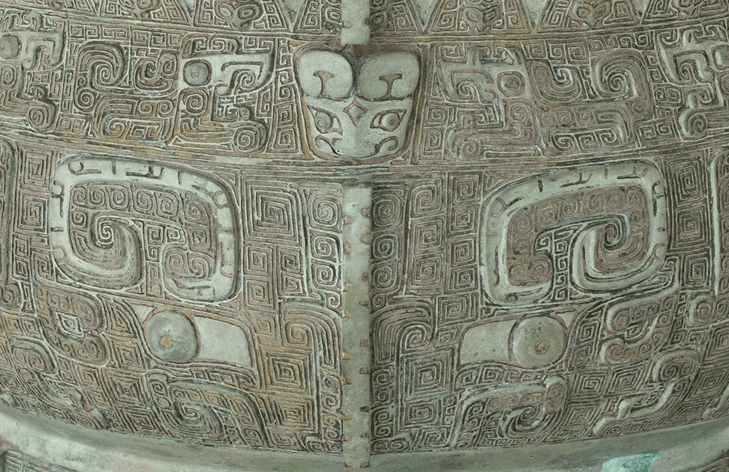Many have marveled at the intricate designs adorning the bronze vessels of the Shang dynasty in ancient China. Among the most distinctive motifs found on these artifacts is the Taotie (T’ao T’ieh, 饕餮), a frontal animal-like mask with a pair of prominent eyes, nose, and other features. These Taotie motifs, along with other decorative patterns like dragons, birds, and geometric designs, reflect the artistic and cultural sophistication of the Shang society during the Bronze Age.
Understanding the Taotie

Definition and Characteristics
Characteristics of the Taotie image found on Shang dynasty bronze vessels are distinctive and symbolic. This frontal animal-like mask typically features a pair of prominent eyes, sometimes protruding in high relief, with a nose and sometimes jaws, fangs, horns, ears, and eyebrows. Many versions also include a split animal-like body with legs and tail on either side of the mask. Despite following a general form, the appearance and specific components of the Taotie masks varied by period and place of production.
Evolution of the Taotie Motif
With the Shang dynasty being the earliest archaeologically recorded dynasty in Chinese history, the evolution of the Taotie motif provides insight into the social and cultural changes of the time. The Taotie motif was a common decorative element on Shang ritual bronze vessels, alongside other motifs such as dragons, birds, bovine creatures, and geometric patterns. The significance of the Taotie, as well as other decorative motifs, in Shang society remains a topic of ongoing study and interpretation.
Symbolism and Interpretations
Cultural Significance
One of the most distinctive and characteristic images on Shang-dynasty bronze vessels is the Taotie, a frontal animal-like mask featuring a pair of eyes, nose, jaws, fangs, and various other components. This motif, along with dragons, birds, and geometric patterns, adorned ritual vessels of the time. The significance of the Taotie in Shang society remains largely unknown, but its repeated appearance suggests a cultural and symbolic importance attached to these designs.
Theoretical Perspectives on the Taotie’s Meaning
To probe into the potential meanings and interpretations of the Taotie motif, scholars have proposed various theoretical perspectives. Some suggest that the Taotie represented clan symbols or mythical creatures, serving as a form of visual communication or representation of power. Others view the Taotie as embodying themes of sacrifice or divine protection, drawing connections to the religious and ceremonial practices of the era.
Further research and analysis are needed to fully understand the complex layers of symbolism embedded in the Taotie and other decorative motifs of Shang-dynasty bronze vessels. By exploring different theoretical perspectives, we can gain deeper insights into the cultural, religious, and social contexts that shaped the artistic expressions of this fascinating period in Chinese history.
Artistic Techniques and Craftsmanship

Bronze Casting Methods
All early Chinese bronzes were created using the piece-mold casting method, distinct from the lost-wax method used by other Bronze Age cultures. This technique involved creating a model of the object, making a clay mold of the model, cutting the mold into sections, and reassembling them after firing to form the mold for casting. The advantages of this method included the ability to carve or stamp intricate designs directly onto the mold, resulting in sharp and defined patterns on the bronze objects.
Artistry in Shang Dynasty Bronze Works
Bronze objects from the Shang dynasty were intricately decorated with distinctive motifs such as the Taotie, which featured a frontal animal-like mask with prominent eyes, nose, and other elements. Other common decorative motifs included dragons, birds, bovine creatures, and geometric patterns. The significance of these motifs in Shang society remains unclear, but they symbolized the artistic and technical mastery of the time, representing the highest achievements in Bronze Age material culture.
During the Shang dynasty, jade carving reached its pinnacle after 2,000 years of development. Jades were used in various ceremonial practices, including sacrificial offerings, burial rites, treaty recordings, and court ceremonies. The craftsmanship of Shang artisans in both bronze and jade works reflected the sophisticated artistry and technical skills of the era, showcasing the cultural and artistic legacy of the dynasty.
Rituals and Ceremonies
Once again, the Shang and Zhou dynasties of ancient China showcase the importance of rituals and ceremonies in their societal structure. Rituals held a critical role in maintaining social cohesion and statecraft within these early civilizations. The use of bronze vessels in these rituals not only served practical purposes but also held significant symbolic meanings.

The Role of Bronze Vessels in Rituals
Rituals in the Shang and Zhou dynasties often involved the use of intricately crafted bronze vessels. These vessels were not merely utilitarian objects but were considered crucial elements in the performance of sacred ceremonies. The elaborate designs and decorations on these vessels, such as the Taotie motifs, likely carried symbolic significance and reflected the beliefs and values of the societies that produced them.
Depiction of Taotie in Ceremonial Contexts
Taotie, the iconic animal-like mask motif found on many Shang dynasty bronze vessels, played a significant role in ceremonial contexts. The prominent pair of eyes, symbolic jaws and fangs, horns, and other features of the Taotie likely held specific meanings within the rituals of the time. These depictions not only added aesthetic value to the vessels but also contributed to the overall ritualistic atmosphere of the ceremonies.
Plus, the variability in the appearance and components of the Taotie masks across different periods and regions suggests a deep sophistication in symbolism and ritual practices during the Bronze Age of China. The use of such intricate motifs in ceremonial contexts underscores the meticulous attention to detail and the rich cultural heritage of the Shang and Zhou dynasties.
Iconographic Analysis
Not only are the Taotie masks visually striking in their appearance on Shang dynasty bronze vessels, but they also hold significant cultural and symbolic value. The prominent pair of eyes, nose, jaws, and other components of the Taotie suggest a complex and intriguing iconography that scholars continue to study and interpret.
Comparative Study with Other Bronze Age Motifs
Study suggests that the Taotie motif on Shang dynasty bronze vessels stands out when compared to other motifs from the Bronze Age period. While dragons, birds, bovine creatures, and geometric patterns were common on ritual bronze vessels, the Taotie motif with its animal-like characteristics and specific components appears to have held a unique role in the artistic repertoire of the time.
| Category | Characteristics |
| Dragons | Mythical creatures associated with power and strength |
| Birds | Symbols of freedom and spiritual connection |
| Bovine Creatures | Representations of fertility and abundance |
| Geometric Patterns | Symbolic designs with unknown meanings |
The Taotie’s Place in the Mythological Repertoire
Mythological interpretations of the Taotie suggest a connection to ancient Chinese beliefs and symbolism, possibly representing a mythical creature or deity. The Taotie’s inclusion on ritual vessels alongside other symbolic motifs points to its significance in religious or ceremonial contexts during the Shang dynasty.
Repertoire: Further research and analysis may shed light on the specific role and meaning of the Taotie within the mythological narratives of the Shang dynasty, providing valuable insights into the spiritual and cultural practices of this ancient civilization.
Influence on Later Dynastic Art
To understand the lasting impact of the iconic Taotie motif beyond the Shang dynasty, it is vital to acknowledge its significance in shaping the artistic expressions of later dynasties. The intricate designs and symbolic meanings attached to the Taotie motif continued to resonate in Chinese art long after the demise of the Shang dynasty. From the Zhou to the Han dynasties, elements of the Taotie motif can be found in various art forms, indicating a continuous reverence for the cultural heritage established during the Bronze Age of China.
Modern Interpretations and Legacy
Later interpretations of the Taotie motif in contemporary art and design continue to showcase the enduring appeal and versatility of this ancient symbol. Modern artists and designers draw inspiration from the intricate patterns and bold imagery of the Taotie motif to create innovative artworks that blend traditional aesthetics with contemporary sensibilities. The legacy of the Taotie motif serves as a testament to the enduring influence of ancient Chinese art forms on modern creative expressions.
Summing up
Presently, the significance of the Taotie motif on Shang dynasty bronze vessels remains unknown, yet its dynamic and intricate design continues to captivate scholars and art enthusiasts alike. The Taotie, with its distinctive features of eyes, nose, fangs, and other animal-like attributes, serves as a key element in understanding the artistic and cultural expressions of the Shang society. Alongside other motifs such as dragons, birds, and geometric patterns, the Taotie reflects the artistic sophistication and symbolic language of the Bronze Age in China.
Despite the mystery surrounding its meaning, the Taotie demonstrates the artistic prowess and technical skill of Shang craftsmen, as well as their mastery in bronze casting techniques. The enduring legacy of this iconic motif on Shang dynasty bronze vessels speaks to the rich artistic heritage and cultural complexities of ancient Chinese civilization during the Bronze Age.
